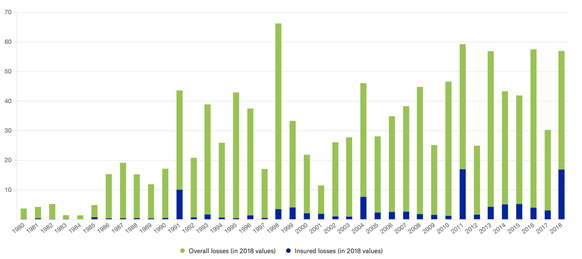
Like the rest of the world, Asia has been hit hard by the COVID-19 crisis. While some countries have been able to contain the spread of the virus relatively well, the disruption of supply chains, sharp decline in global demand, and the large-scale withdrawal of capital have led to severe economic contractions across the region.
The COVID-19 crisis has illustrated in dramatic ways the vulnerability of our societies and economies. It has also laid bare the failure of individual countries and the international community at large to adequately prepare for pandemic risks, despite previous outbreaks, such as the Severe Acute Respiratory Syndrome (SARS) pandemic in 2002–2003 and the H1N1 influenza pandemic in 2009, and repeated warnings by virologists about the risks of even worse outbreaks.
When building back our economies after the crisis, we need to make them more resilient—not only to better withstand future pandemics but also to increase resilience against the other great threat scientists have been warning us about for long—climate change. We need to strengthen resilience and mitigate disaster risk by systematically developing and implementing policies, strategies, and practices to minimize vulnerabilities throughout society.
The financial sector will have to play a central role in this. Managing risk is one of the key functions of finance. Financial institutions need to develop their ability to better assess climate-related financial risks, including physical risks and transition risks. The frequency and intensity of climate-related disasters have grown markedly over the last decades, and parts of Asia are among the most affected regions. As shown in Figure 1, climate-related disasters in Asia have led to significant losses. Financial institutions across Asia will need to grow their capacity to analyze the effects of acute physical risks. These include risks that are event-driven, including extreme weather events, such as typhoons, floods, or heatwaves, and chronic physical risks, such as rising sea levels and temperature increases that are due to longer-term shifts in climate patterns. Moreover, financial institutions will have to account for transition risks related to a move to a lower-carbon economy, including changes in policy, technology, and consumer preferences.
Figure 1: Overall and Insured Losses for Relevant Weather-Related Loss Events in Asia, 1980–2018

($ billion)
Source: NatCatSERVICE.
The Intergovernmental Panel on Climate Change has laid out the urgent need to limit global warming to 1.5°C compared to pre-industrial levels. To achieve this, it will not only be necessary to adopt more forceful climate policies, such as meaningful carbon prices, but also to shift investment and lending patterns away from carbon-intensive industries and toward low-carbon and energy-efficient activities. The financial sector has to play a key role in scaling up sustainable finance. But this will not happen by market forces alone. Financial governance needs to make sure that financial firms take seriously the threats posed by climate change and integrate physical and transition risks into their lending and investment frameworks.
Encouragingly, central banks across Asia have been showing greater awareness of sustainability risks and are acknowledging the need for them to act in helping to align the financial system with sustainable development. A survey we conducted among 18 central banks in Asia and the Pacific last year showed that sustainable finance is a topic of growing importance and relevance to monetary authorities in the region, particularly since many of these countries are being severely affected by the effects of climate change. It was refreshing to see that the vast majority of central banks responding to the survey believed that they should be playing a key role in promoting green finance and sustainable funding options, either through amending the regulatory framework, encouraging green loans and products, or introducing climate change considerations in their monetary and financial policy operations. Indeed, a growing number of Asian central banks and supervisory authorities are already promoting sustainable finance, either explicitly or implicitly.
Awareness is also rising among Asian banks and investors. The Asia Investor Group on Climate Change, an initiative to create awareness among Asia’s asset owners and financial institutions about the risks and opportunities associated with climate change and low-carbon investing, has recently joined other international investor groups to call on governments to “factor in the foreseeable, acute, systemic and compounding climate-related economic and financial risks”.
It is important that the turmoil caused by the COVID-19 pandemic will not deter the resolve of central banks and supervisors to speed-up efforts to integrate environmental and climate risks into financial decision-making. If anything, the COVID-19 crisis highlights the need to strengthen systemic thinking and be better prepared to mitigate the risk of future crises. Monetary and financial authorities across Asia should work on developing and introducing prudential instruments, such as carbon-based capital requirements, and require banks and other financial institutions to conduct climate stress-testing around different scenarios. Last but not least, it is also imperative to make climate-related financial disclosure reporting mandatory. The recommendations by the Task Force on Climate-Related Financial Disclosures provide a good framework that is increasingly being taken up by supervisory bodies across the region.
There are indeed some positive examples in Asia of monetary and financial authorities advancing the sustainability agenda despite COVID-19. In March, Bangko Sentral ng Pilipinas, the central bank of the Philippines, approved a Sustainable Finance Framework. In May, the Hong Kong Monetary Authority and the Securities and Futures Commission jointly launched a Green and Sustainable Finance Cross-Agency Steering Group to “co-ordinate the management of climate and environmental risks to the financial sector, accelerate the growth of green and sustainable finance in [Hong Kong, China] and support the Government’s climate strategies”. Other monetary and financial authorities should also step up their efforts to mitigate climate risks in the financial sector and promote sustainable finance. Importantly, they should also seek to align their crisis responses with climate and sustainability goals.
The current crisis presents us with a unique opportunity to rethink our economic and financial models and priorities. While supporting economic recoveries, Asian monetary and financial authorities need to continue to scale-up their efforts to align the financial system with sustainability.
_____
References
Dikau, S. and U. Volz. 2019. Central Banking, Climate Change and Green Finance. In Springer Handbook of Green Finance: Energy Security and Sustainable Development, edited by J. Sachs, W.T. Woo, N. Yoshino and F. Taghizadeh-Hesary. New York: Springer, pp. 81–102.
Dikau, S., and U. Volz. 2020. Central Bank Mandates, Sustainability Objectives and the Promotion of Green Finance. SOAS Department of Economics Working Paper No. 232. London: SOAS University of London.
Durrani, A., M. Rosmin, and U. Volz. 2020. The Role of Central Banks in Scaling Up Sustainable Finance – What do Monetary Authorities in the Asia-Pacific Region Think?. Journal of Sustainable Finance and Investment, (10)2: 92–112. (For an open access version, see ADBI Working Paper No. 1099.)
Semieniuk, G., E. Campiglio, J.-F. Mercure, U. Volz, and N. R. Edwards. 2020. “Low-Carbon Transition Risks for Finance. SOAS Department of Economics Working Paper No. 233. London: SOAS University of London.
Volz, U. 2019. Fostering Green Finance for Sustainable Development in Asia. In Routledge Handbook of Banking and Finance in Asia, edited by U. Volz, P. J. Morgan, and N. Yoshino. London and New York: Routledge, pp. 488–504.








Comments are closed.